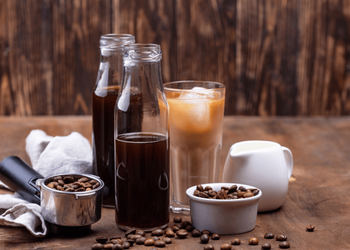
French Press vs Cold Brew: 10 Major Differences to Know

What is French press coffee?
To prepare coffee in a French Press, ground coffee is immersed in water and then left to brew for a few minutes till it is properly extracted. In an immersion brewing method, rather than focusing on controlling the pour, brewers need to be thinking about the brew time.
Keeping track of the entire brewing process is not that necessary, so it is ideal for those who prefer an easy brew method. Also, from what we have observed, immersion brewing results in a bolder coffee profile with a heavy mouthfeel.
For French press coffee, the grinds stay in the bottom of the beaker throughout the entire process. As the grinds remain in contact with the water, the bean extraction doesn’t end till the plunger is pushed down, giving you complete control over the process, and creating an oily and bold taste.
If you prefer mild coffee, this taste may be overbearing. But those who prefer stronger coffee will certainly turn to this brewing technique due to its rich taste and texture.
How to make French press coffee?
To make French Press Coffee, you will need a French Press Coffee Maker, coffee beans, hot water, and a grinder. Here's a step-by-step guide to making French Press Coffee:
- Boil water to the desired temperature, usually between 195-205°F.
- Grind the coffee beans to a coarse texture. Use 1 tablespoon of coffee grounds per 110 ml of water.
- Add the coffee grounds to the French Press, pour in hot water, and stir to ensure all the grounds are wet.
- Allow the coffee to steep for 4-5 minutes. The longer the coffee steeps, the stronger it will be.
- Once the coffee is brewed, gently press the plunger down, separating the brewed coffee from the grounds.
- Pour the coffee into a mug and enjoy.
If you like to experiment with your coffee like us, you can try your hand at various recipes using French press coffee.
What are the distinct characteristics of a French press coffee?
French Press Coffee has some distinct characteristics that set it apart from other coffee brewing methods. For one, it has a fuller and richer taste compared to drip coffee. This is because the coffee grounds are in direct contact with the water for a longer period, allowing for more flavor extraction.
Another characteristic of French Press Coffee is that it has a thicker and more velvety mouthfeel. This is due to the presence of coffee oils and micro-grounds that are not filtered out like in other brewing methods.
Lastly, French Press Coffee has a more complex and nuanced flavor profile. The longer steeping time allows for the extraction of subtle notes and flavors that may not be present in other brewing methods.
![Woman pouring French press coffee from the French press coffee maker into cup]](https://uploads-ssl.webflow.com/638680794255d655ea1eac12/6426e4e5064d7410ed1650fe_image%201.png)
What is cold brew coffee?
The cold brew dates back to the 1600s when Dutch trading ships in Japan started brewing coffee without the use of fire to make it easy to carry during voyages. The Dutch brought their concentrate over to Japan, and cold brew coffee gained popularity as the Japanese developed their own brewing methods.
In Kyoto, they use cold tea brewing techniques for their coffee using towers and tubes to utilize gravity for a hands-off approach. Thus, the Japanese Kyoto-style brews are an extension of this brewing process.
Like the French Press, cold brewing is also an immersion technique where ground coffee beans are steeped in cold or room-temperature water for 12 to 24 hours. The concentrate that you get after straining this is the cold brew. It has a great mouthfeel, is much less acidic, and is known to have more caffeine than regular coffee.
The smooth, sweet taste of cold brew coffee has made it very popular. A hot water brew produces acids that professional coffee tasters call ‘brightness.’ A cold water brew produces a distinct mouthfeel and sweetness while producing less acidity.

How to make cold-brew coffee?
Cold brewing is probably the most hassle-free method of making coffee. The 12-hour wait might prove to be a bit difficult, but apart from that, we love everything about this coffee. Want to try making it at home? Let us fetch out our cold brew recipe for you!
Requirements
- Coarsely ground coffee
- Cold or room-temperature water
- Air-tight container
- Strainer
Steps
- Fill your container with water. (4 parts of water for 1 part of coffee)
- Add the measured coarse coffee grounds to the water.
- Cover your container and let it steep for at least 12 hours.
- If you can wait longer, add in a couple of hours for better results.
- When it’s done soaking, strain the coffee concentrate.
- Add the desired amount of water or milk, and enjoy.
What are the distinct characteristics of a cold brew coffee?
The key factors that set it apart from hot-brewed coffee are that it brews cold, brews for at least 8 hours, and carries lesser bitterness. Also, the cold brew process prevents acid development. Moreover, cold brew makes great iced coffee as the milk only enhances its smoothness and richness.
Interestingly, while a lot of emphasis is laid on using fresh coffee beans for a cold brew, you can let off this worry. Even if your beans are not freshly roasted, your cold brew will turn out well. Another area where the cold brew scores well is the caffeine content.
So, if you want a real refill of energy, having a well-brewed cold brew will do the job for you.
French press coffee vs cold brew: Quick comparison
The main difference between a French press coffee and a cold brew coffee is that a French press coffee is made using a full-immersion brewing process where coarsely ground coffee steeps in hot water, and a plunger with a metal or mesh filter separates the grounds from the liquid. On the other hand, cold brew coffee is a method that involves steeping coarsely ground coffee in cold water for an extended period, typically 12-24 hours.
French press coffee is a robust and full-bodied coffee with rich oils and sediment, offering a bold and intense coffee experience that many coffee enthusiasts appreciate. On the other hand, cold brew is known for its milder, sweeter flavor and can be served over ice, often diluted with water or milk.
Let's explore the other differences.
1) Brewing temperature
While both French press and cold brew require coarsely ground beans, it is recommended to keep cold brew grinds extra coarse.
2) Bean type
French press coffee is brewed using hot water, around 195-205°F. Cold brew coffee, on the other hand, is brewed using cold or room-temperature water.
3) Brewing time
French press coffee takes about 4-5 minutes to brew, while cold brew coffee takes several hours to extract coffee from the beans, usually 12-24 hours.
4) Taste
French press coffee has a full-bodied and bold taste, with a slight bitterness and acidity. Cold brew coffee, on the other hand, has a smoother, less acidic taste, with a prominently sweet flavor.
5) Grind type
While both French press and cold brew require coarsely ground beans, it is recommended to keep cold brew grinds extra coarse.
6) Bean type
Both French press coffee and cold brew coffee can be made with any type of coffee bean, but some roasts may work better for one method over the other. For example, medium to dark roasts work well with French press coffee, and cold brews are best made with dark roasts. You can check out our picks for the best cold-brew coffee beans to get a better idea.
7) The difference in the brewing method
French press coffee is brewed by steeping coffee grounds in hot water and then using a plunger to separate the grounds from the liquid. Cold brew coffee is made by steeping coffee grounds in cold water for several hours, and then filtering out the grounds.
8) Need for other equipment
To make French press coffee, you need a French press and a kettle to heat the water. To make cold-brew coffee, you only need a container to steep the coffee grounds in and a filter to strain out the grounds.
9) Caffeine Level
Cold brew coffee generally has a higher caffeine concentration than French press coffee because it is brewed using a larger quantity of coffee grounds.
10) Cost and convenience
As far as the convenience of time is concerned, French press coffee is a better option as it doesn’t take more than 5 minutes to prepare a mug of hot coffee. However, when cost and effort come into question, the cold brewing method is a clear winner as it doesn’t require anything more than a container and a basic filter to make coffee.
French press coffee vs cold brew: Which one to choose?
When choosing between French press coffee and cold brew coffee, there are several factors to consider. Here are some parameters you can weigh your options on -
Personal preference
Your personal taste and preference for coffee flavor have to be the first thing to consider when choosing between French press and cold brew coffee. If you prefer a strong and bold flavor with a slight bitterness, French press coffee may be the better choice. If you prefer a smoother, less acidic flavor with a slightly sweet taste, cold brew coffee is what you should go for.
Occasion
The occasion or purpose for your coffee may also play a role in choosing between French press and cold brew coffee. If you need a quick and easy cup of coffee in the morning or during a break, French press coffee may be a more practical choice. On the other hand, if you are planning a leisurely brunch or hosting a party and want to offer a variety of coffee options, cold brew coffee has to be your pick.
Time and effort
The time and effort required to prepare the coffee will also influence your decision. French press coffee requires boiling water and a few minutes to steep, making it a relatively quick and easy option. Cold brew coffee, on the other hand, requires several hours to steep and must be prepared in advance. If you are short on time or prefer a quick cup of coffee, the French press may be the better option.
Equipment availability
While French press coffee requires the use of a French press and a kettle to heat the water, cold brew coffee requires a container for steeping the grounds in and a filter for straining.
Budget
Finally, you might want to consider your budget. Cold brew coffee requires more coffee grounds but almost no equipment. French press coffee, on the other hand, requires fewer coffee grounds and is made in a French press. So, there is not much difference when it comes to affordability.
Wrapping up
The bottom line is that both French press coffee and cold brew coffee have their own unique taste and characteristics. French press coffee is known for its full-bodied flavor and richness, while cold brew coffee is praised for its smoothness and low acidity.
Ultimately, the choice between the two comes down to personal preference and the desired flavor profile. Those who prefer a strong, bold coffee may prefer French press, while those who enjoy a smoother, less acidic taste may prefer a cold brew. Regardless of which method is chosen, both French press and cold brew coffees can be enjoyed as delicious and refreshing beverages.
- To make cold brew in a French press, you'll want to start by coarsely grinding your coffee beans. A good rule of thumb is to use a 1:4 coffee-to-water ratio, so for every cup of coffee you want to make, you'll use 4 cups of cold water.
- Add the coffee grounds to the French press, then pour in the cold water and give it a stir. Place the lid on the French press, but don't press down the plunger. Instead, let the mixture steep in the refrigerator for 12-24 hours.
- Once the coffee has steeped, slowly press down the plunger to separate the grounds from the liquid. Pour the cold brew coffee into a separate container and store it in the refrigerator until you're ready to enjoy it.

I am a barista by profession hailing from NC. My journey began in my late teens when I started working as a barista in a local coffee shop. My passion for coffee quickly became evident as I immersed myself in the art of espresso extraction, latte art ...



